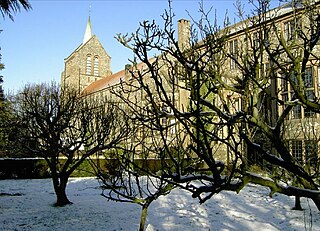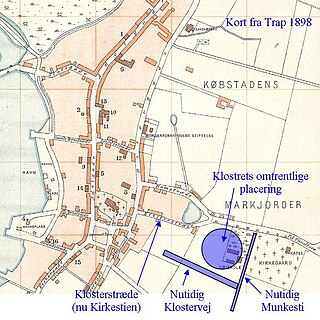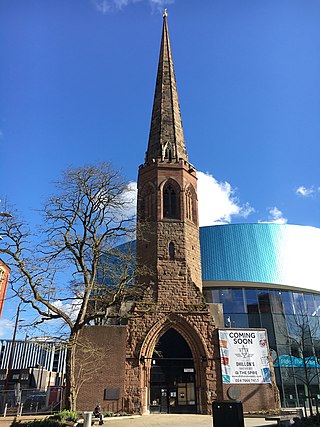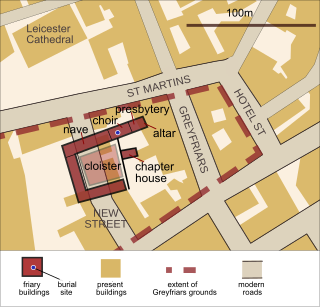
Greyfriars is a Roman Catholic friary and parish located in East Oxford, which until 2008 was also a permanent private hall of the University of Oxford. Situated on the Iffley Road in East Oxford, it was one of the smallest constituent halls of the university. Its status as a permanent private hall (PPH) derived from the fact that it was governed by an outside institution, rather than by the fellows of the University as a constituent college is.

Christ Church Greyfriars, also known as Christ Church Newgate Street, was a church in Newgate Street, opposite St Paul's Cathedral in the City of London. Established as a monastic church in the thirteenth century, it became a parish church after the Dissolution of the Monasteries. Following its destruction in the Great Fire of London of 1666, it was rebuilt to the designs of Sir Christopher Wren. Except for the tower, the church was largely destroyed by bombing during the Second World War. The decision was made not to rebuild the church; the ruins are now a public garden.
Greyfriars, Grayfriars or Gray Friars is a term for Franciscan Order of Friars Minor, in particular, the Conventual Franciscans. The term often refers to buildings or districts formerly associated with the order.

Greyfriars Church is an evangelical Anglican church, and former Franciscan friary, in the town centre of Reading in the English county of Berkshire. The church forms part of the Church of England's Diocese of Oxford.

All Saints' Church is a Roman Catholic parish church situated between Dumplington and Barton upon Irwell, near Urmston, in Trafford, Greater Manchester, England. The church was constructed between 1867 and 1868 and was designed by E. W. Pugin in the Gothic Revival style for Sir Humphrey de Trafford. It is situated on Redclyffe Road, close to the Manchester Ship Canal. The church is a Grade I listed building and considered to be an example of Pugin's best work, according to Nikolaus Pevsner, "the masterpiece of [Pugin's] life, without any doubt." It has been served by priests from the Conventual Franciscans since 1928.

Nysted Friary, located in Nysted, on the island of Lolland in southern Denmark, now in Guldborgsund municipality in Region Sjælland, was the last occupied Franciscan friary in Denmark after the Reformation.
John Blount, 3rd Baron Mountjoy was an English peer and soldier.

Greyfriars in Canterbury was the first Franciscan friary in England.

Greyfriars, in Bristol, England, was a Franciscan friary. The name Greyfriars derived from the grey robes worn by the friars. It was founded at some time before 1234, within the town walls and then moved to Lewin's Mead in 1250. The site included extensive gardens surrounded by a stone wall. Following the Dissolution of the Monasteries in the sixteenth century, the premises were leased to the town council in 1541, who desired to use the stone to make repairs to the town walls, and the harbour facilities. In succeeding centuries many different uses have been made of the site, which is currently occupied by an office block and part of Bristol Dental School.
Greyfriars, Beverley was a Franciscan friary in Beverley, the East Riding of Yorkshire, England. It was established before 1267, probably by John de Hightmede, but the exact date is not known. Originally located within the town walls near today's St Mary's Terrace, it was moved outside Keldgate, near Westwood, about 1297. After it had fallen into disrepair in the 1330s, the knight Sir John Hotham of Scorbrough provided funds for its rebuilding in the 1350s. Several members of his family were buried there later. The friary benefitted further from grants made by nobles and merchants. The friars acknowledged royal supremacy in 1534, and the monastery was surrendered to the Bishop of Dover on 25 February 1538–39. Although no buildings of the friary have survived, it is remembered by the street name "Greyfriars Crescent".
Dorchester Friary, also known as Dorchester Priory, was a Franciscan friary formerly located in Dorchester, Dorset, England.
Colchester Greyfriars, otherwise the Franciscan Friary, Colchester, was a Franciscan friary in Colchester, Essex, England, situated to the north of the town's east gate. It was founded sometime before 1237. In 1309 the friars received a grant of half an acre of land from Robert Fitzwalter, Lord Fitzwalter, on which he built their church. According to John Weever, the antiquarian, in his Ancient Funerall Monuments, Fitzwalter became a friar here himself in 1325, and was buried here.

The Greyfriars, Lincoln was a Franciscan friary in Lincolnshire, England. The surviving building is the remains of the infirmary of the friary, built of dressed stone and brick and dating from c.1230, with mid-19th-century additions. The clay tile roof of the main building is in a poor condition and the Welsh slate roof of the 19th-century extension has been repaired.

Greyfriars was a medieval Franciscan priory in Coventry, England. The original monastic buildings were lost in the Reformation; the spire standing on the site today was most recently part of a 19th-century church that was destroyed in an air raid in the Second World War. The spire, also called Christchurch Steeple, is a Grade II* listed building.

Greyfriars, Leicester, was a friary of the Order of Friars Minor, commonly known as the Franciscans, established on the west side of Leicester by 1250, and dissolved in 1535. Following dissolution the friary was demolished and the site levelled, subdivided, and developed over the following centuries. The locality has retained the name Greyfriars particularly in the streets named "Grey Friars", and the older "Friar Lane".

Ipswich Blackfriars was a medieval religious house of Friars-preachers (Dominicans) in the town of Ipswich, Suffolk, England, founded in 1263 by King Henry III and dissolved in 1538. It was the second of the three mendicant communities established in the town, the first being the Greyfriars, a house of Franciscan Friars Minors, and the third the Ipswich Whitefriars of c. 1278–79. The Blackfriars were under the Visitation of Cambridge.

Ipswich Greyfriars was a mediaeval monastic house of Friars Minor (Franciscans) founded during the 13th century in Ipswich, Suffolk. It was said conventionally to have been founded by Sir Robert Tibetot of Nettlestead, Suffolk, but the foundation is accepted to be set back before 1236. This makes it the earliest house of mendicant friars in Suffolk, and established no more than ten years after the death of St Francis himself. It was within the Cambridge Custody. It remained active until dissolved in the late 1530s.

St Patrick's Church is a Roman Catholic parish church in Waterloo, London. It was built in 1897, designed by Frederick Walters. A Victorian Romanesque Revival style building that houses both the church and a school, it is located on the corner of Cornwall Street and Secker Street, to the east of St John's Church, Waterloo. It is served by the Franciscan Order of Friars Minor Conventual, and it is their only church in London.

The Friary, formally known as Blessed Agnellus of Pisa Friary, formerly All Saints Convent or St John's Home is a centre of formation for the Franciscan Order of Friars Minor Conventual in Cowley, Oxford, England. The building was constructed in 1873 as the convent of the Anglican Society of All Saints Sisters of the Poor. It is situated between St Mary's Road and Cowley Road, next to St John's Care Home and Helen & Douglas House. The friary and its chapel are Grade II listed buildings.

















